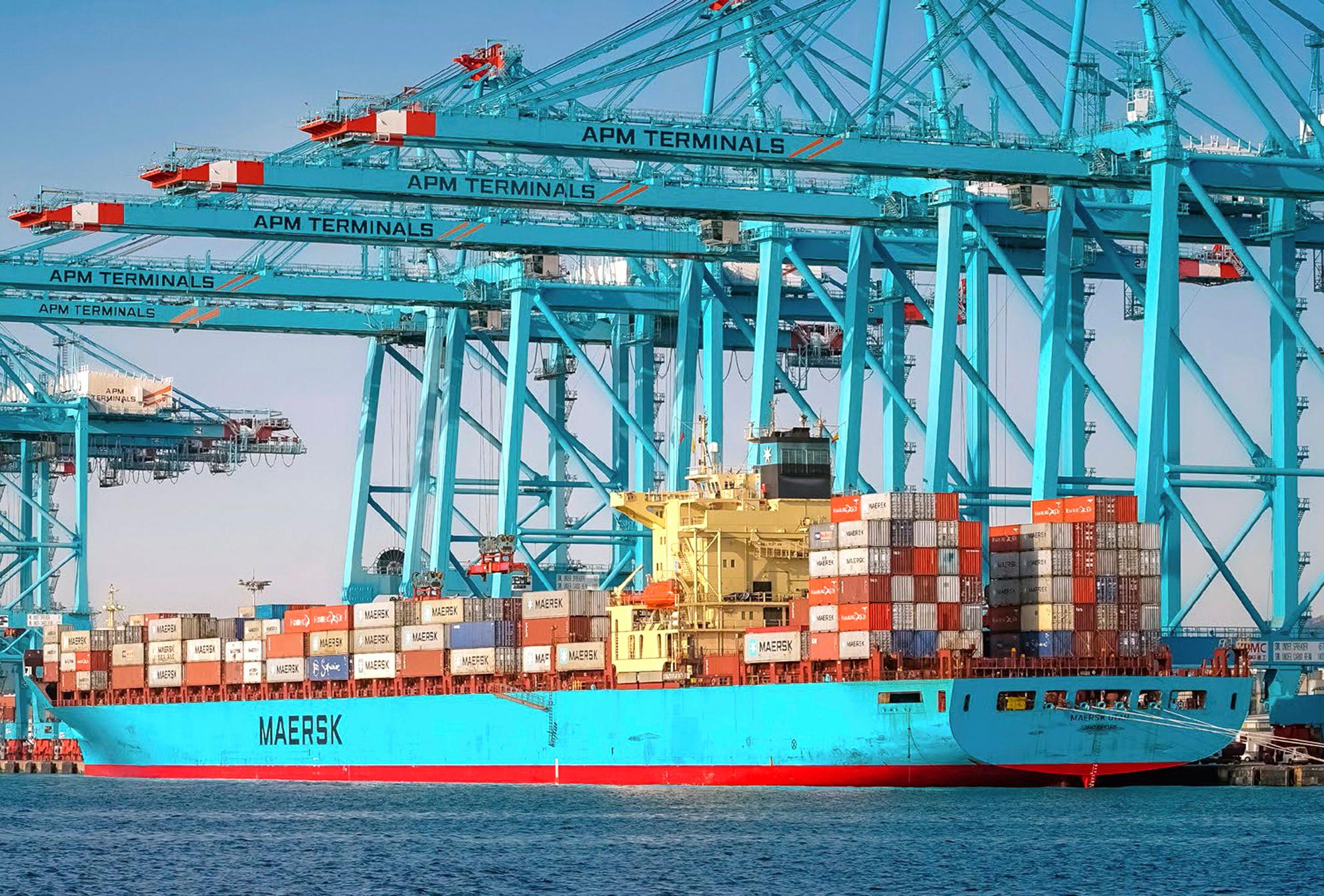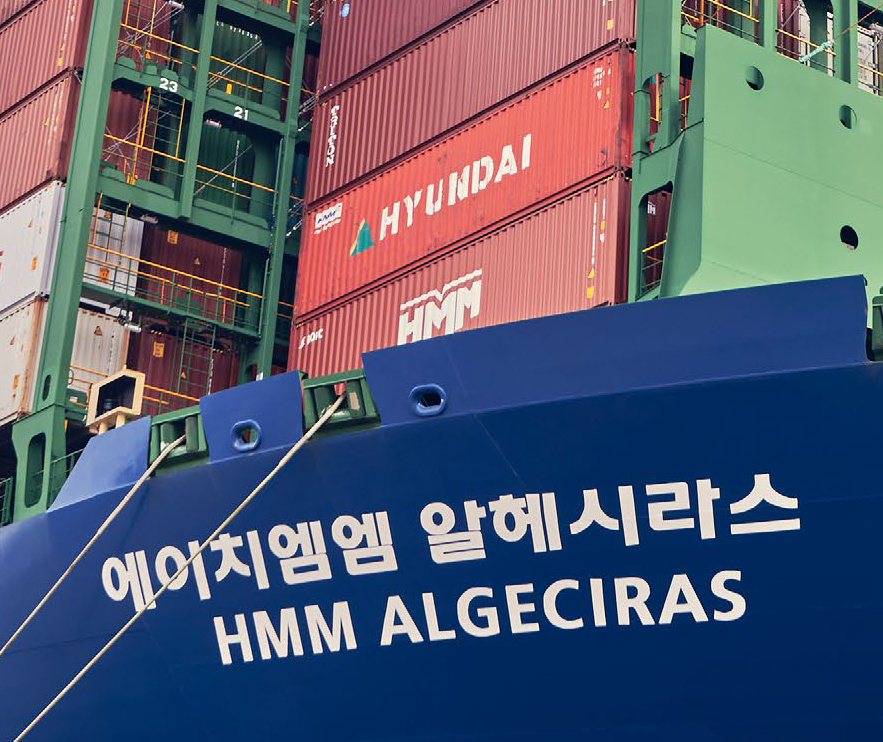
01
Between two worlds
The port of Algeciras ranks first in Spain and fourth in Europe in total volume of goods, with a traffic of more than 108 million tonnes in 2022, its second best historical record. Its natural conditions of shelter and draught and its strategic geographical location, at the southern tip of the Iberian Peninsula - between the Mediterranean and the Atlantic, just where, according to Greek myth, the legendary Pillars of Hercules were located - place it on the main international maritime routes. Ineco has been collaborating for years with the APBA port authority and the Adif railway administrator in the extension and improvement of railway connections, which are vital for goods to continue their journey through the logistics chain in a more sustainable way. Thus, the company is currently working on both the internal network ("last mile" project) and the external access, the Bobadilla-Algeciras line. The section, in the process of renovation, forms part of the "rail motorway" (transport of lorries on board trains) that will connect with the large logistics hubs of Madrid and Zaragoza, and is one of the pillars of the Hercules Project, the strategic plan of the port authority.
02
A port 'plus ultra'
Goods, whether manufactured products or unprocessed raw materials, trace back the "logistics" or supply chain from their production centre to the end consumer. Ports are key points in the process, and even more so in a peninsular and island territory such as Spain, the European country with the most kilometres of coastline. They are infrastructures of great economic importance: according to the public body Puertos del Estado, 85% of imports and 55% of exports pass through them.
The port of Algeciras Bay, in the south of Spain, ranks first in Spain in terms of total volume of cargo traffic, according to data from Puertos del Estado: in 2022, for the seventh year in a row, it exceeded 100 million tonnes again - specifically, 108, 3% more than the previous year - a fifth of the country's total. It is also an important enclave for maritime passenger traffic, with more than five million passengers a year. Its activity has grown to place it in fourth place in Europe for cargo - only surpassed by Rotterdam, Antwerp and Hamburg - the first in the Mediterranean and among the 25 most important in the world.
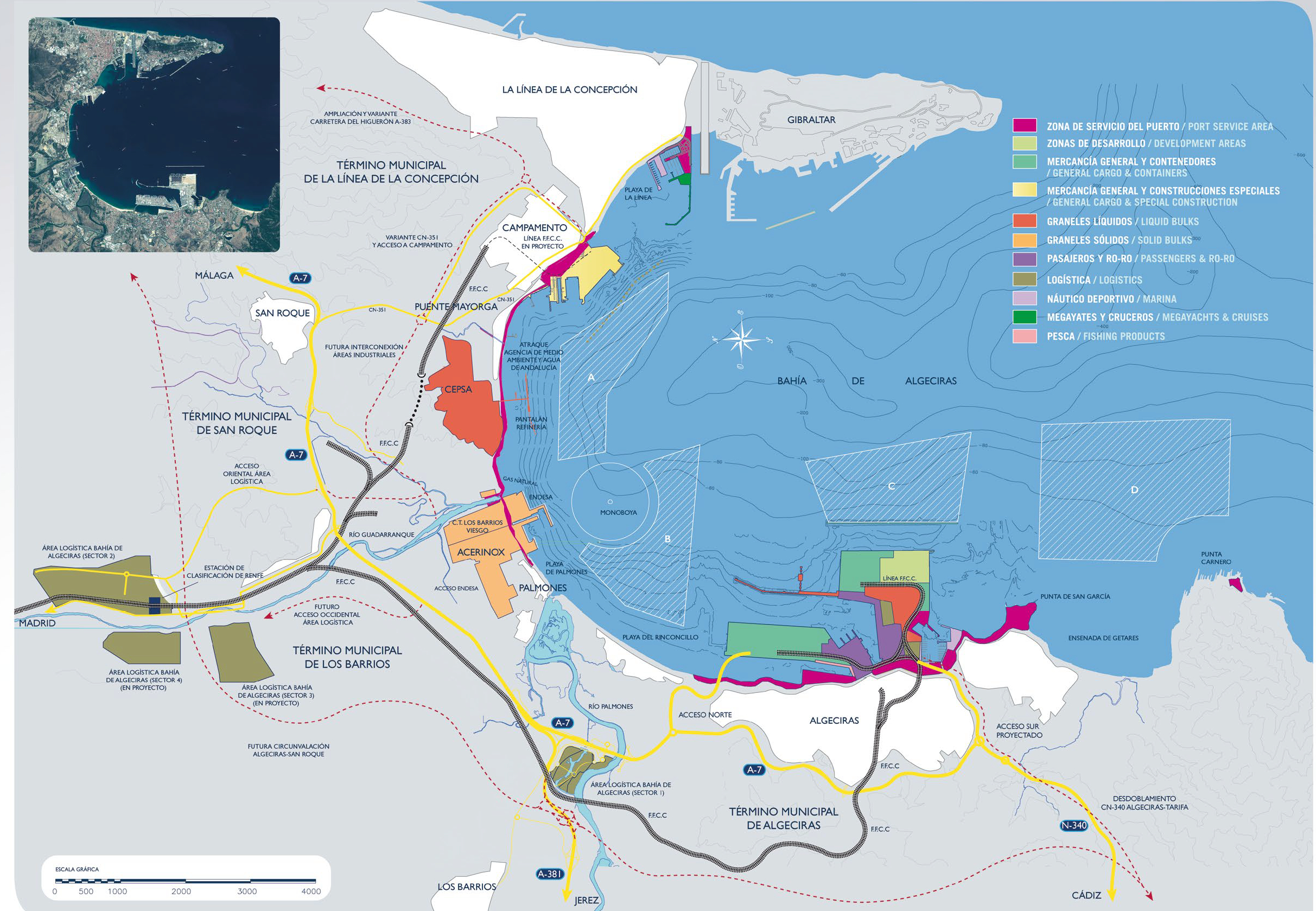
The service area of the port has been extending since the 1960s along the entire shore of the bay from its original nucleus, in the municipality of Algeciras (123,000 inhabitants), where the the passenger terminal (where three companies operate), the fishing dock, the marina, the ro-ro area (roll on-roll off or roll off or roll on roll off cargo, either as passenger vehicles or cargo trucks in transit, especially to or from Morocco) and the large container terminals of the outer Isla Verde and Juan Carlos I docks, with their characteristic cranes, more than thirty in total, are located.
Along the coastal fringe are the logistics and industrial areas: the Acerinox factory, the Endesa energy company, which produces electricity, and the Cepsa refinery. Each has port terminals specialised in the different types of cargo - solid bulk, liquid bulk, general cargo - that their activity requires. The Campamento shipyards are located next to La Línea de la Concepción.
Its strategic location, next to the Strait of Gibraltar, together with the natural conditions of shelter and draft of the Bay of Algeciras, gives it a key position in east-west shipping routes, with connections to more than 200 ports around the world. A location where, precisely, Greek mythology placed the legendary "Pillars of Hercules", considered until the 7th century BC to be the limit of the known world; hence the motto "Non plus ultra" ("There is no beyond") associated with them.
Nothing could be further from the reality of the current port, which not only constitutes one of the most important economic poles in the south of Spain, but also extends its hinterland (area of influence) to a large part of the national territory.
"...Then there is a very high mountain opposite the one which, on the other side, rises in Hispania: they call this mountain 'Abila', the other 'Calpe' and the two together 'Pillars of Hercules' (...) it was Hercules himself who separated the two mountains (...) and that it was thus that the Ocean (...) was given entrance to the places it now floods". Pomponius Mela, Chorography (1st century AD).
Pillars of Hercules
The "Torres de Hércules" business centre was inaugurated in 2009 in the Las Marismas de Los Palmones industrial park, next to the Acerinox terminal. To evoke the mythical "columns", the architect Rafael de La-Hoz designed two twin towers 126 metres high and 20 storeys high, connected by glass walkways. The white concrete lattice covering them is formed by large letters reproducing the motto "Non plus ultra".
According to legend, the hero forcibly parted the waters to form the Strait of Gibraltar, and then erected two pillars to commemorate the event. One pillar is often likened to the Rock of Gibraltar (called Calpe in antiquity) and the other one (Abyla) to Mount Hacho in Ceuta, or Mount Musa in Morocco.
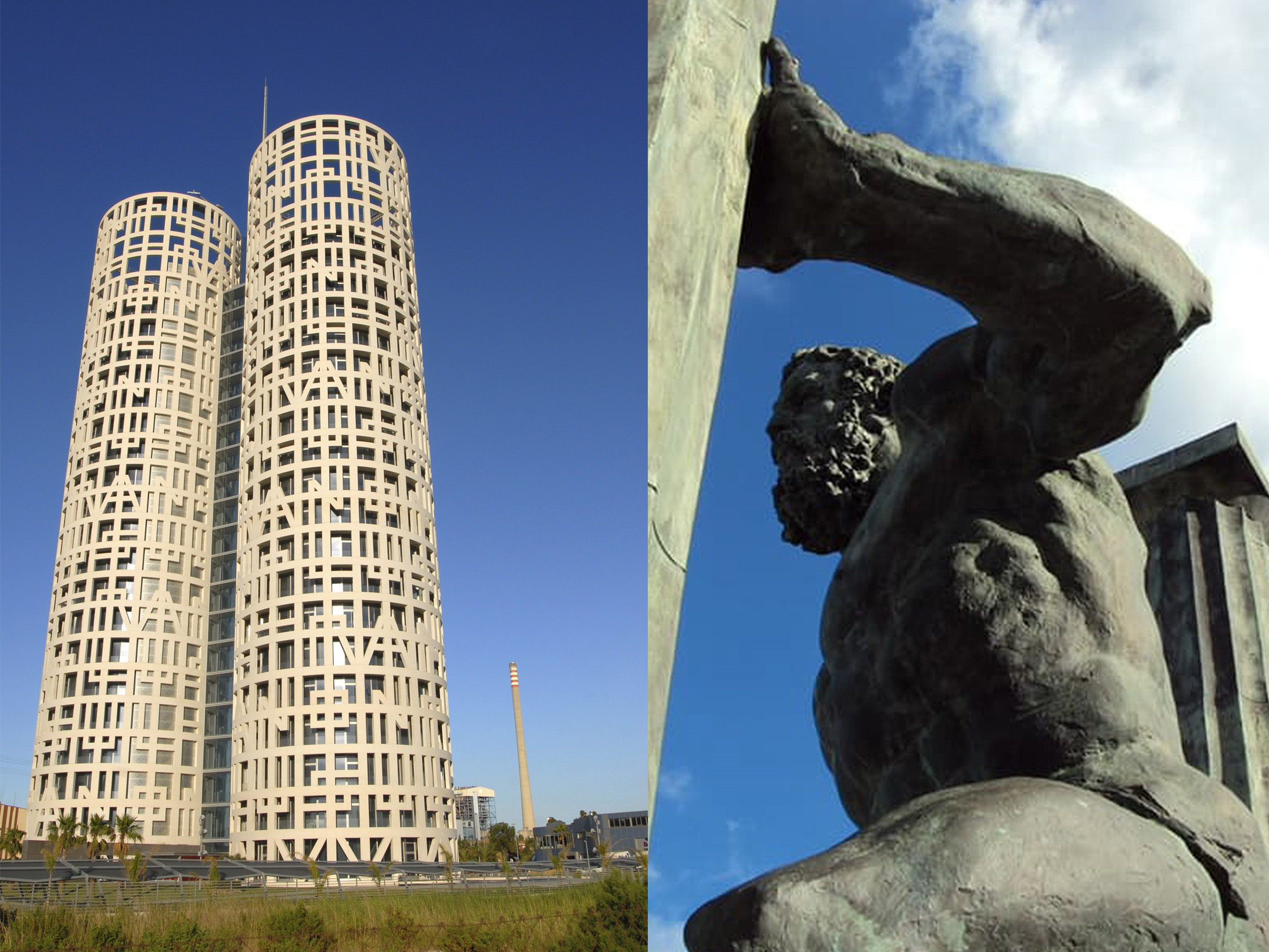
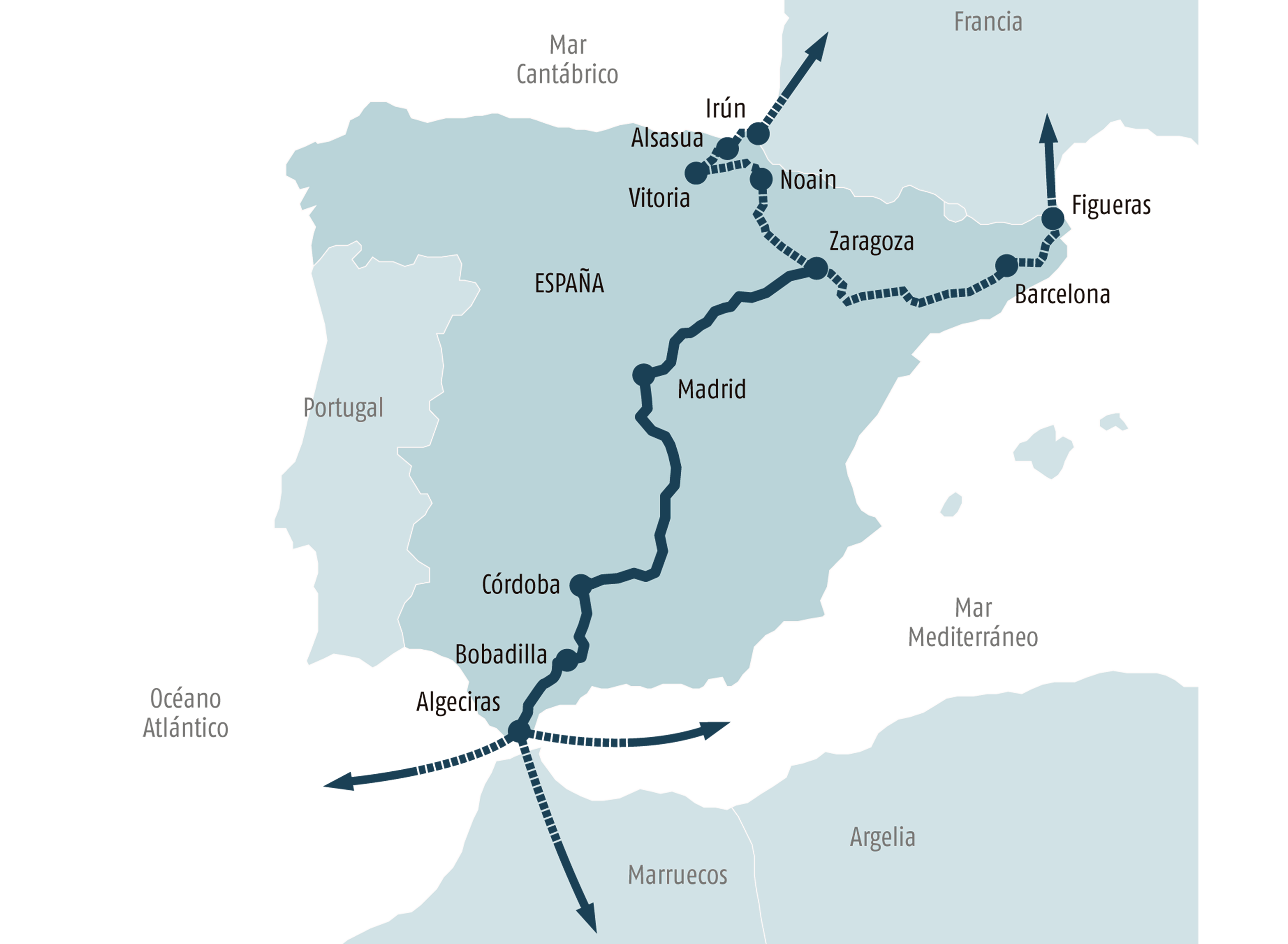
The Algeciras-Bobadilla line forms part of the central branch of two of the nine priority rail corridors of the Trans-European Transport Network, T-TNT, as it passes through the Iberian Peninsula: the Mediterranean and the Atlantic.
Spain has 46 ports classified as "general interest", managed by 28 port authorities that operate with great autonomy and business criteria under the land lord model, in which the ownership is state-owned but the services are concessioned to the private sector; as opposed to the tool lord model, in which a single agent, public or private, holds the ownership and provides the services.
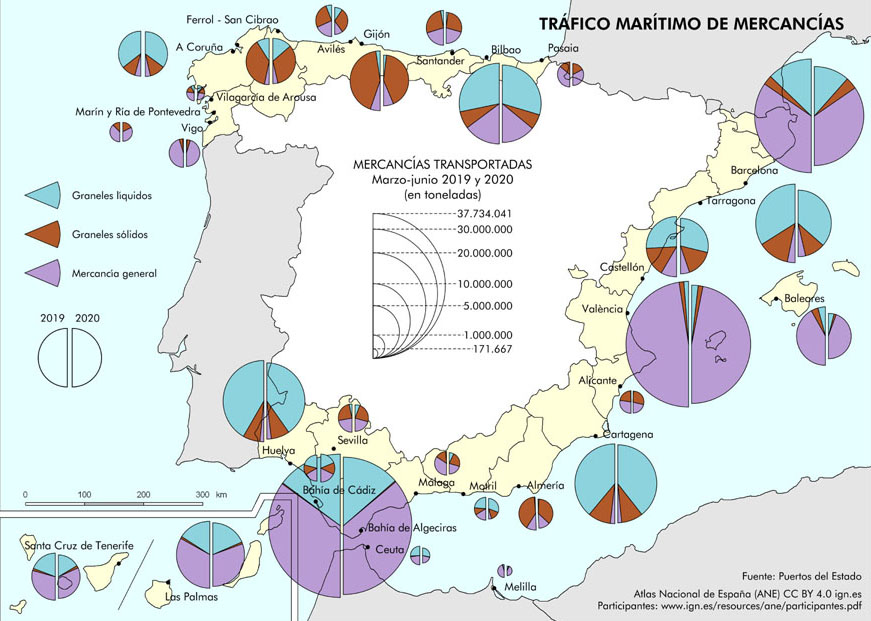
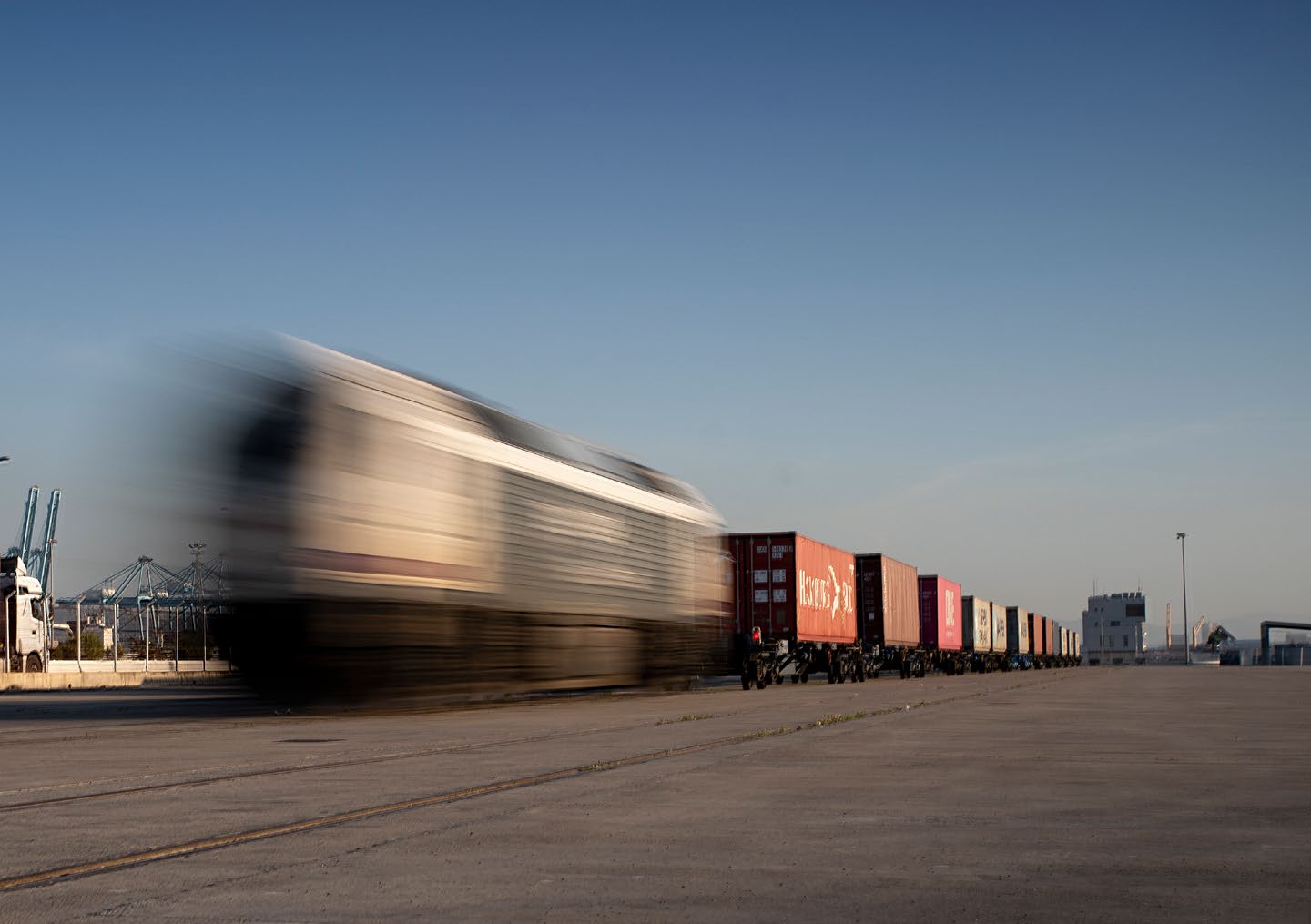
The urgent need to combat climate change and comply with the European objectives to reduce polluting emissions, together with the growing road congestion, are determining factors in Algeciras' commitment to the railway, included in the port authority's strategic plan, the Hercules Project, presented in 2021.
However, historically, the natural environment - a mountainous terrain with steep slopes - of the port's only external rail access, the port's only external rail access, the 176 km Algeciras-Bobadilla line - or line 420 in Adif's nomenclature - has historically limited the capacity and development of rail freight transport.
For this reason, Adif, the state rail infrastructure administrator, has been carrying out a comprehensive renovation of the line in recent years, in which Ineco is collaborating. The section is of strategic importance, as it forms part of the central branch of the European Mediterranean and Atlantic corridors, and of the "rail motorway" to Zaragoza, a major project for which the company is also carrying out various works.
To make it a reality, actions are also required in the railway network of the port of Algeciras and its surroundings (projects to improve the railway port capacity and the "last mile"), a task in which Ineco is also collaborating, in this case with the port authority.
03
Rail motorway: lorries on the back of trains
The Algeciras-Zaragoza rail motorway is a 1,074 km freight corridor on Iberian gauge - currently in the testing phase, with plans to start operating in 2024 - for 750-metre convoys adapted to transport semi-trailers or containers with their load, with daily frequency. It will connect the largest seaport in Spain with the "dry ports" in the centre of the Peninsula (Madrid and Guadalajara, in which it participates as a shareholder) and the PLAZA multimodal logistics centre in Zaragoza, which is also home to the airport with the highest volume of cargo in the country (after Madrid and Barcelona).
" In a world where freight is becoming a key part of new services and climate change calls for urgent solutions, it is necessary to offload road traffic and transfer it to more efficient and less polluting transport systems. Truck transport by rail improves traffic, increases service quality, is more respectful and environmentally sustainable". Adif: Rail Motorways. Needs for action in the Network (2019).
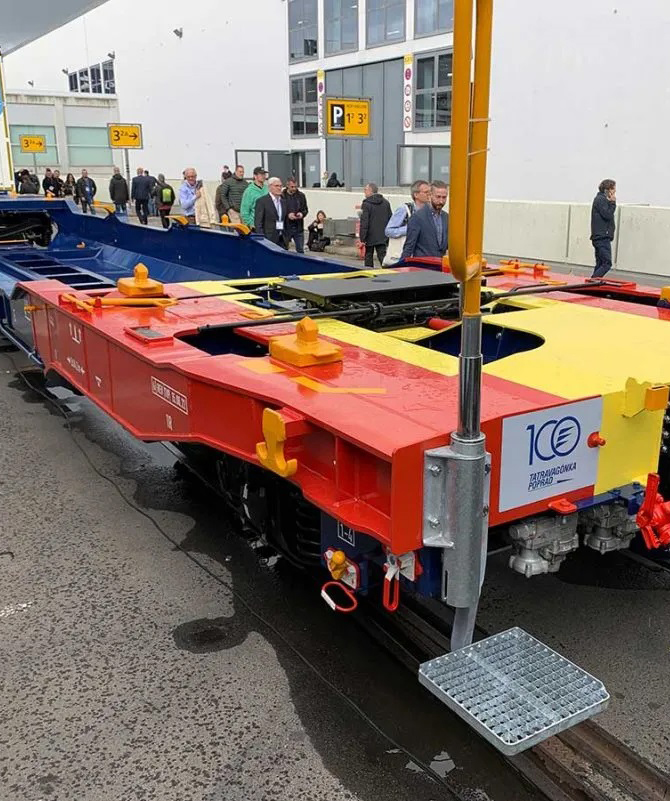
A rail motorway is, according to the definition of the Spanish infrastructure manager Adif, "a combined transport system in which road vehicles (lorries) are transported by rail in shuttle services using rolling stock (trains) and terminals specifically equipped according to the type used". In other words, it is both a physical infrastructure and a multimodal transport service, with regular frequencies and high capacity, characterised by the reduction in both emissions and costs it offers compared to road.
Ferroutage has existed in Europe for decades; a significant example is that of the English Channel, where the Eurotunnel operator Le Shuttle Freight currently offers 800-metre shuttle trains with frequencies of up to 6 services per hour, 24 hours a day, all year round. The Spanish motorway will start, in principle, with rather more modest targets: one service per day.
There are different systems and technologies for loading and unloading lorries and/or their cargo: complete vehicles, only semi-trailers, with or without driver, in low-floor trains, with mobile platforms, etc. Each of these requires different adaptations of both the railway infrastructure and terminals and the rolling stock and the vehicles themselves.
The system to be applied on the Algeciras-Zaragoza rail motorway is the poche or pocket wagons system, for vertical loading: unloading with gantry crane of the semi-trailers (it is also suitable for containers), which will travel without a driver (unaccompanied system). The wagons have reinforced platforms that are lower than usual to support the weight of the cargo. The operator, the company Rail&Truck, will be in charge of acquiring the rolling stock, which will have to be manufactured specifically for Iberian gauge.
As for the railway infrastructure, the first element to be taken into account so that the trains, which are more voluminous than normal ones, can run, are the gauges - a concept that Adif defines as "minimum obstacle-free space around the track so that a certain type of train can run on it with the proper safety conditions" - of the tunnels, overpasses and other structures (totalling some 400 between Zaragoza and Algeciras).
In relation to the adaptation of gauges, the company is drafting for Adif the construction projects for the adaptation of the Bobadilla-Algeciras line in the tunnels of El Colmenar, El Callego, La Camilla 1 and La Camilla 2, as well as the fitting out of sidings for long trains.
This is precisely another of the keys to the efficiency of the future rail motorway: longer trains = more capacity and lower costs per tonne. In order for them to operate, it is necessary to extend sidings and stations, since until just over a decade ago the usual effective rake length of freight trains in Spain was between 300 and 450 metres, almost half the European average.
For this reason, over the last decade, improvements have been made to the railway infrastructure that allowed Adif to authorise the first 600-metre train to run between Madrid and Valencia in 2009, the first 750-metre train in 2011, and, from 2016, to extend authorisation to any point on the network where the infrastructure allowed it. In 2022, with an execution period of 24 months, work began on the extension to 750 metres in fifty sidings throughout the national network, approximately half of which are located on the route of the future rail motorway.
The Algeciras-Zaragoza railway motorway, 6 keys issues:
WHAT: Combined rail transport service for semi-trailers on board 750-metre trains.
HOW: EIn the railway infrastructure, it is necessary to increase the gauges of tunnels and other structures to allow the passage of convoys, which are more voluminous than normal ones, and to enable sidings and stations for long trains.
WHERE: 1,074 kilometres, the distance between the port of Algeciras and the Plaza logistics platform in Zaragoza.
WHY: Reduction of costs compared to road, and of polluting emissions: it has been calculated that 94,170 tonnes of CO2 per year.
WHO: Support and funding from the public sector (Adif, APBA, Minister of Transport, Mobility and the Urban Agenda, regional governments of Aragon and Andalusia) and the private sector (shipping companies, rail and road transport companies, customers...). The service will be operated by the private company Rail&Truck, formed by the logistics company Marcotran, the railway company Eco Rail and the shipping company CMA CGM.
WHEN: It is expected to start operating in the first half of 2024.
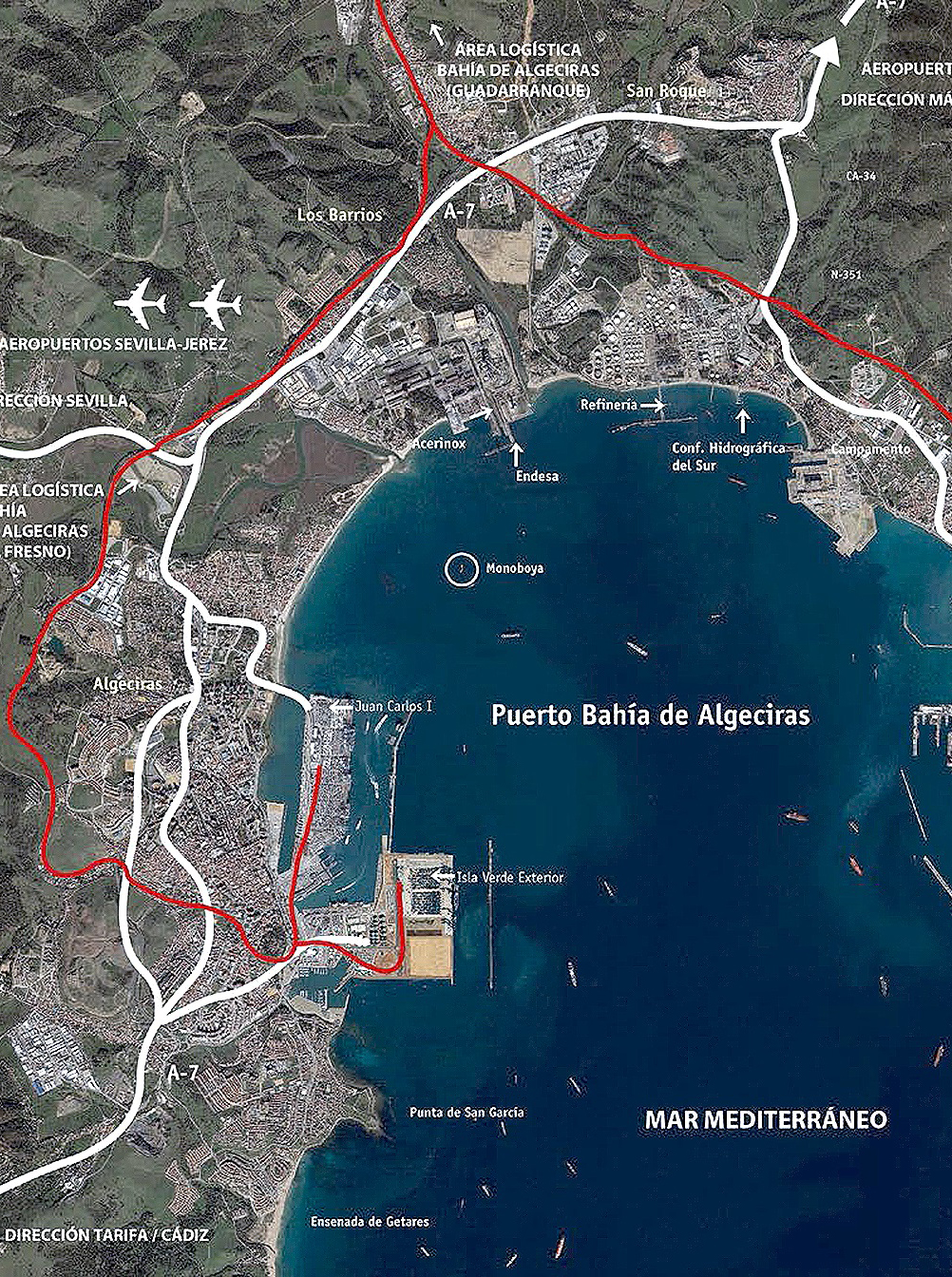
04
More capacity for the "last mile" : from the ship to the track
The rail motorway will start right at the docks, but in order for the large freight trains that will run along it to be able to operate, it is necessary to lengthen the effective rake lengths of the port's interior network.
It is managed by the port authority of Algeciras and consists of three branches, which join the Bobadilla-Algeciras line via the southern access. Branches 1 and 2, which connect the outer and inner Isla Verde terminals, have two fan of sidings on the first (of which the one at the Juan Carlos I terminal is not operational) and one on the second, with effective rake lengths of between 300 and 600 metres. Branch 3 is the rail link between terminals 1 and 2 with 263 metres long.
The projects to improve the capacity of the "last mile" and the rail connection that Ineco is drawing up for the Algeciras Bay Port Authority aim to accommodate 750-metre trains. To this end, actions are planned within the port area, such as the enlargement of the Isla Verde exterior (T1) and Isla Verde interior (T2) rail-port terminals. In T1, the rail yard will be extended to accommodate at least two 750-metre-long tracks, suitable for simultaneous loading and unloading, while in T2 it is planned to extend the effective rake length to 550 metres or more, and to reconfigure the interior roads.
In addition to these interventions, there are two others already outside the site; given that space is required for storing and sorting trains, a technical facility has been designed a short distance from the port, a five-track yard with a effective rake length of 750 metres, which will function as a siding. Finally, a 5.4 km connecting branch line has been planned between the new facility and the port, which will run parallel to the existing track.
The objective of these works is to double the current capacity of the Port of Algeciras Bay to handle freight trains by 2025. In November 2022 it managed to reach, for the first time, the symbolic figure of 1000 trains in a single financial year, which according to the APBA is equivalent to having diverted more than 25,000 lorries from the road.
05
Bobadilla-Algeciras renovation: a "labour" worthy of Hercules
Behind the port's border, Ineco has been working for Adif for years on the modernisation of the port's rail exit: the conventional passenger and freight line Bobadilla-Algeciras, with 176 km and 18 stations.
Built on single track of "Iberian gauge" (1668 mm.), without electrification, by the British company The Algeciras & Gibraltar Railway Company Limited, the initial intention of its promoters was to connect the Peninsula with Gibraltar, although the Spanish authorities prevented it for strategic reasons. Work began in 1888 and was completed in 1892.
The alignment, with numerous curves of reduced radius (less than 300 metres) runs through steep, mountainous terrain with gradients of up to 1,000 metres, so it has 19 tunnels and cut-and-cover tunnels - most of them concentrated between Cortes de la Frontera and Gaucín, right in the centre of the route - and as many overpasses. Most of the alignment was built in the only space available: following the canyon of the Guadiaro River. From Ronda onwards, moreover, the line enters two protected natural areas, the Grazalema and Los Alcornocales natural parks.
Thus, historically, the characteristics of the natural environment have imposed limitations on the speed, length and power of the trains running on the track, especially for freight trains. Moreover, in addition to the natural difficulty of the terrain, there are also the constraints related to environmental protection when it comes to carrying out the works.
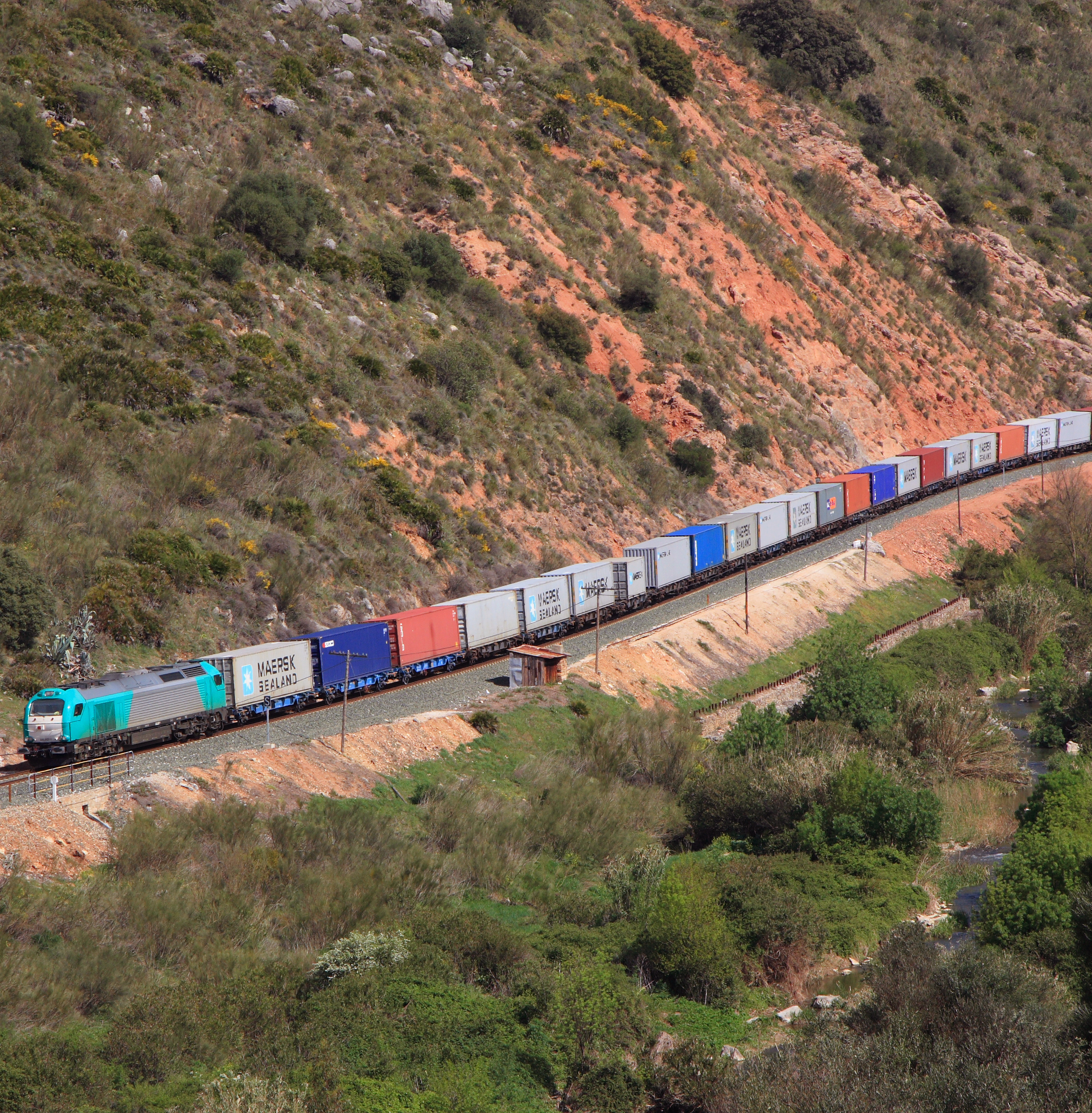
In 2007, studies began to modernise the line. As for track renewal, between 2008 and 2011 Adif carried out a first phase of improvement works on the route between Ronda and Algeciras, in which Ineco provided environmental and works management services, as well as technical assistance for supervision and surveillance, on two of the three sections: Ronda -San Pablo and San Pablo-Almoraima. For the third, Almoraima-Algeciras, it prepared alternative studies and environmental documentation, and drafted the construction project. The works carried out included the renewal of sleepers, ballast and rail, stabilisation of slopes and embankments to prevent landslides, and reinforcement of tunnels and cut-and-cover tunnels, in which an initial increase in gauges was also carried out with a view to electrification.
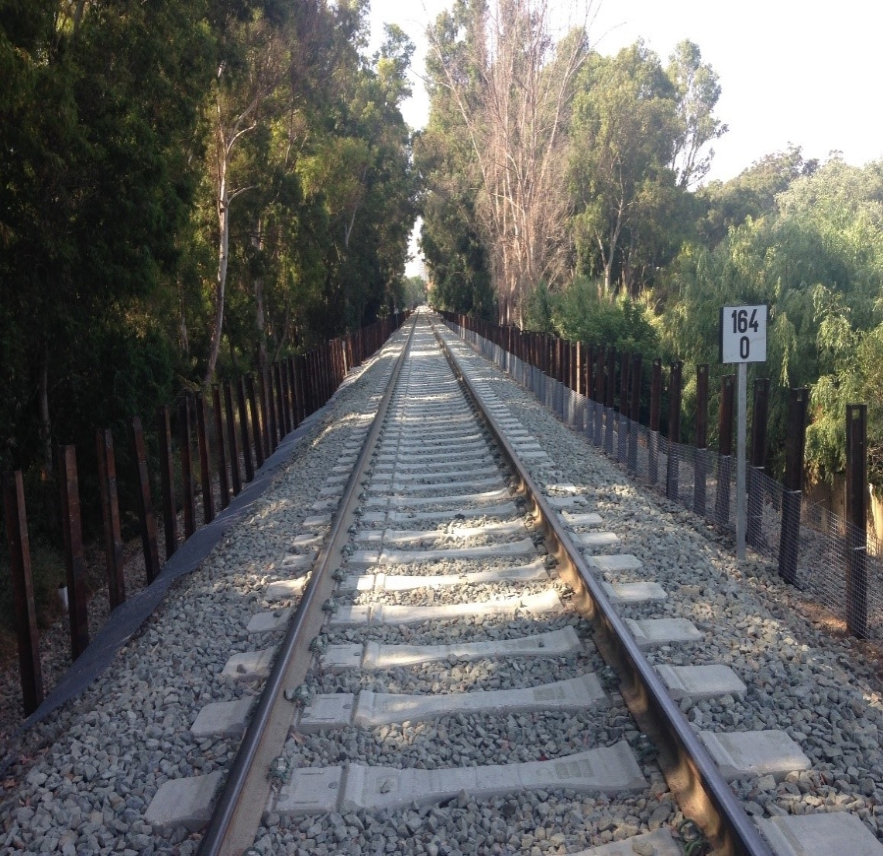
The company is currently providing technical assistance services to monitos and supervise the second phase of the renovation of the San Pablo-Almoraima section, as well as the fourth phase of the Almoraima-Algeciras section, where the renewal of the platform and track has been carried out with a new bypass route; and the San Roque Mercancías station has been remodelled, with three new sidings of more than 750 metres.
Work also continues on electrification, which is key not only to improve railway operations (the future overhead contact line prepared for 25kV will allow a maximum operating speed of up to 200 km/h) but also to make it sustainable by eliminating diesel traction. Ineco, which in 2012 carried out, among other works, the preliminary design of the entire line, concluded for Adif in 2020 and 2021 the drafting of the construction projects of the two sections into which the route has been divided: Bobadilla-Ronda (73.6 km) and Ronda-Algeciras (107.2 km), respectively. The railway administrator has planned for the line to be supplied with 25 kV alternating current, using a system with autotransformers, from two traction substations in Castellar and Ronda (not included in these projects). The connection with the Córdoba-Málaga high-speed line will be located at a point near Antequera-Santa Ana station, bridging the Bobadilla station, which is already electrified with a 3 kV direct current system.
Other improvements underway include the replacement, on the Bobadilla-Ronda section, of the telephonic blocks (the systems that prevent trains from colliding) with an ABS (Automatic Block Signalling) that will operate with Centralised Traffic Control (CTC), which is already installed on the rest of the line; the renewal of the signalling between Ronda and Algeciras (digital ASFA train protection system, fixed and luminous LED signalling, fixed telecommunications with the deployment of the IPMM data network and updating of the power system); the extension of the Campillos and Setenil sidings to 750 metres and the elimination of three level crossings. Adif has also planned to implement the third rail, which will make it possible for trains to run on the single track in two gauges (Iberian and international, 1435 mm).


